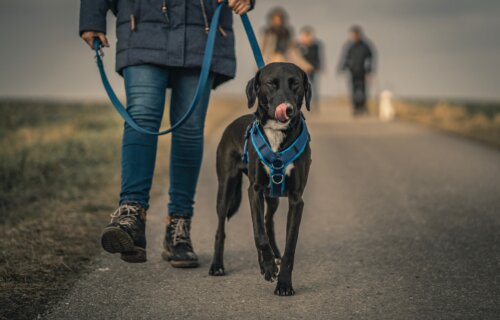RALEIGH, N.C. — A slower walking pace in old age already has an association with dementia risk in humans. Now, researchers from North Carolina State University have made similar findings with older dogs. Study authors report that older pets who slow down physically also tend to slow down mentally. As such, researchers suggest that measuring gait speed among senior dogs could serve as a simple, yet effective way to monitor their health and document eventual declines in neurological function as they grow older.
“Walking speed in people is strongly associated with cognitive decline,” says Natasha Olby, the Dr. Kady M. Gjessing and Rahna M. Davidson Distinguished Chair in Gerontology at NC State and corresponding author of the study. “We hypothesized that the same might be true in dogs.”
The research team measured gait speed off leash among 46 adult and 49 senior dogs. Study authors considered the adult dogs the healthy control group, and only measured their gait speed. The senior dogs, on the other hand, underwent additional cognitive testing and their owners filled out a cognitive assessment questionnaire (the CADES questionnaire). A higher CADES score indicates more significant cognitive decline.
The senior pups were placed in groups based on their CADES and cognitive testing scores. To start, the team measured individual gait speed by walking the dogs over a five-meter distance on a leash with a handler, then by offering a treat the same distance away from the dogs and calling for them to retrieve it off their leash.
“The challenge with measuring gait speed is that dogs tend to match the speed of their handler when on leash, so we measured both on and off leash to see which was the most useful measure,” Olby explains in a university release.
“Additionally, we are always concerned that body size and limb length will affect gait speed – but if you see a chihuahua and a great dane walking together off leash, the shorter one isn’t always behind the other,” the study author continues. “We found that on leash, size does correlate with gait speed, but off leash it doesn’t make a difference. Capturing gait speed off leash lets us see the effects of both physical ability and food motivation.”

Study authors report that among the senior dogs, size didn’t matter regarding speed. In other words, dogs in the last 25 percent of their expected lifespan moved more slowly than adult dogs, regardless of their relative sizes.
“Just as in humans, our walking speed is pretty stable through most of our lives, then it declines as we enter the last quarter or so of our lifespan,” Olby notes.
Senior dogs who moved more slowly displayed more severe levels of cognitive decline based on the owner-completed questionnaires. Those same dogs also performed worse on the cognitive testing.
Study authors also discovered that joint pain does not appear to correlate at all with walking speed. They do, however, admit that none of the dogs had been diagnosed with severe osteoarthritis. Future research should address this issue.
“When you look at functional aging, the two most important predictors of morbidity are mobility and cognition,” Olby concludes. “Mobility relies heavily on sensory input, central processing and motor output – in other words, the nervous system – as a result, mobility and cognition are super interconnected. When you have less mobility, the amount of input your nervous system gets is also reduced. It’s not surprising that walking speed and dementia are correlated.”
“For me, the exciting part of the study is not only that we show gait speed correlates with dementia in dogs as in people, but also that the method of testing we used is easy to replicate, since it’s food motivated and over a short distance. It could become a simple screening test for any veterinarian to perform on aging patients.”
The study is published in the journal Frontiers in Veterinary Science.
You might also be interested in:
- Best Of The Best Dog Breeds For Families: Top 5 Pups To Bring Home, According To Experts
- Best Of The Best Dog Leashes In 2023: Top 5 Most Recommended By Experts For Your Pet
- Best Joint Supplements For Dogs: Top 5 Products Most Recommended By Experts
- Hearing loss linked to dementia among older dogs

